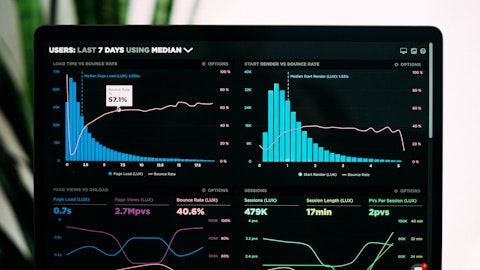Zions Bancorporation, National Association (NASDAQ:ZION) Q3 2023 Earnings Call Transcript October 18, 2023
Zions Bancorporation, National Association beats earnings expectations. Reported EPS is $1.13, expectations were $1.1.
Operator: Greetings, and welcome to the Zions Bancorp Q3 Earnings Conference Call. At this time, all participants are in a listen-only mode. A brief question-and-answer session will follow the formal presentation. [Operator Instructions] As a reminder, this conference is being recorded. It is now my pleasure to introduce your host, Shannon Drage, Interim Director of Investment. Thank you, Shannon. You may begin.
Shannon Drage: Thank you, Alicia, and good evening. We welcome you to this conference call to discuss our 2023 third quarter earnings. My name is Shannon Drage, Interim Director of Investor Relations. I would like to remind you that during this call, we will be making forward-looking statements, although actual results may differ materially. We encourage you to review the disclaimer in the press release or Slide 2 of the presentation dealing with forward-looking information and the presentation of non-GAAP measures, which applies equally to statements made during this call. A copy of the earnings release as well as the presentation are available at zionsbancorporation.com. For our agenda today, Chairman and Chief Executive Officer, Harris Simmons, will provide opening remarks.
Following Harris’ comments, Paul Burdiss, our Chief Financial Officer, will review our financial results. Also with us today are Scott McLean, President and Chief Operating Officer; Keith Maio, Chief Risk Officer; and Derek Steward, Chief Credit Officer. After our prepared remarks, we will hold a question-and-answer session. This call is scheduled for one hour. I will now turn the time over to Harris Simmons.
Harris Simmons: Thanks very much, Shannon, and we want welcome all of you to our call this evening. Zions Bancorporation recently celebrated the 150th anniversary of its, what we think of as an ancestral bank, which was Zion’s Savings Bank & Trust Company, which opened for business in October of 1873. I would like to think that this is a bank that’s been built the right way, steadily and prudently over many decades, with a persistent focus on developing deep roots in the communities we serve and helping customers develop their own strong financial foundations. As one of the West’s most prominent pioneer institutions, we look forward to a great future, building on this history and demonstrating a continued commitment to the values that have served us so well over these many years.
One other thing that I want to comment on before we get into the numbers. During this past quarter, Michael Morris, who has very capably served as our Chief Credit Officer for the past decade, retired from the role due to some recent health challenges that led Michael and his family to conclude that he should reduce his workload somewhat. I’m very pleased that Michael will continue with us in a role focused on affordable housing and related projects where I know he’ll add a great deal of value. Michael’s close and very capable associate over the past decade, Derek Steward, has assumed the Chief Credit Officer role and as Shannon noted, he’s with us on the call today, and we welcome Derek into this really important position in the company. So going into the slides, financial performance for the quarter was marked by sustained stabilization of our net interest margin as well as significant customer deposit growth, both of which have been very encouraging.
On Slide 3, you’ll see some of the themes that are particularly applicable designs this quarter and these remain fairly consistent with our messaging from the prior quarter. Customer deposits grew $3 billion during the quarter and resulted in reduced reliance on both short-term borrowings and brokered deposits. We continue to actively manage our balance sheet at our hedging in response to changes in our interest rate risk profile. We’ve had a pretty dynamic and proactive response to changing conditions and this has contributed to the stabilization of the net interest margin and net interest income. We recognized $14 million in net charge offs during the quarter, which is in line with the prior quarter, loss absorbing capital increase with common equity Tier 1 capital up 7% compared to the prior year.
Capital levels remain healthy, particularly relative to our risk profile. Turning to Slide 4, we’ve included some key financial performance highlights for the quarter. Circled on the slide we reported total deposit costs of 192 basis points for the quarter compared with 127 basis points in the second quarter. Period end customer deposits increased 5%, brokered deposits decline 22%, bringing total deposit growth to 1% quarter-over-quarter. Period end loans were flat to the prior quarter as we observed softening loan demand in the third quarter. Moving to Slide 5, diluted earnings per share was up $0.02 over the second quarter to $1.13 on net income of $168 million as lower expenses offset slightly lower revenue. Turning to Slide 6, our third quarter adjusted pre-provision net revenue was $272 million, down from $296 million.
The linked quarter decline was attributable to lower non-interest revenue while adjusted non-interest expenses were flat. Versus the year ago quarter, PPNR was down 23% as the increase in the cost of funds exceeded the increase in earning asset yields. With that high level overview, I’m going to ask Paul Burdiss our Chief Financial Officer to provide some additional detail related to our financial performance. Paul?
Paul Burdiss: Thank you, Harris, and good evening, everyone. I’ll begin with a discussion of the components of pre-provision net revenue. Over the three — over three-quarters of our revenue is from the balance sheet through net interest income. Slide 7 includes our overview of net interest income and the net interest margin. The chart shows the recent five quarter trend for both net interest income on the bars and the net interest margin in the white boxes were consistent with the prior quarter as the repricing of earning assets nearly kept pace with rising funding costs. Additional detail on changes in the net interest margin is outlined on Slide 8. On the left hand side of this page, we’ve provided a linked quarter waterfall chart outlining the changes in key components of the net interest margin.
The 109 basis point adverse impact associated with deposits, including changes in both rate and volume, was offset by fewer, more expensive borrowed funds and the positive impact of loans repricing. Our success in continuing to grow customer deposits contributed to the reduced level of brokered deposits and borrowed funds as we moved through the third quarter, and non-interest bearing sources of funds continued to serve as a significant contributor to balance sheet profitability. The right hand chart on this slide shows the net interest margin comparison to the prior quarter. Higher rates were reflected in earning asset yields, which contributed an additional 157 basis points to the net interest margin. This was more than offset by increased deposit and borrowing costs, which when combined with the increased value of non-interest bearing funding, adversely impacted the net interest margin by 189 basis points.
Overall, the net interest margin declined by 31 basis points versus the prior year quarter. Our outlook for net interest income in the third quarter of 2024 is stable relative to the third quarter of 2023. Risks and opportunities associated with this outlook include realized loan growth, competition for deposits and the path of interest rates across the yield curve. Moving to non-interest income and revenue on Slide 9, customer related non-interest income was $157 million, a decrease of 3% versus the prior quarter due to strong capital market fees in the second quarter. Customer fees were in line with the prior year as the year-over-year decrease in capital markets was offset by approved treasury management swap fees. Our outlook for customer-related non-interest income for the third quarter of 2024 is moderately increasing relative to the third quarter of 2023.

A wealth manager holding a tablet, talking to a client in an authoritative setting, highlighting the trust services the company offers.
The chart on the right side of this page includes adjusted revenue, which is the revenue included in adjusted pre-provision net revenue, and is used in our efficiency ratio calculation. Adjusted revenue decreased 8% from a year ago and decreased by 3% versus the second quarter due to the factors noted previously and a $13 million gain on the sale of property recognized in the second quarter. Adjusted non-interest expense shown in the lighter blue bars on Slide 10 was essentially flat to the prior quarter at $493 million. Reported expenses at $496 million decreased $12 million due to $13 million in severance expense recognized in the second quarter. Our outlook for adjusted non-interest expense is slightly increasing in the third quarter of 2024 when compared to the third quarter of 2023.
This outlook excludes any impact associated with the proposed FDIC special assessment. While we have made headway in our effort to flatten expense growth as seen in the current quarter, we expect the timeline for fully achieving our expense objectives to take longer than originally planned. Highlights and trends in our average loans and deposits over the past year are on Slide 11. On the left side, you can see that average loans were somewhat flat in the current quarter. As loan demand continues to soften, our expectation is that loans will be stable in the third quarter of 2024 when compared to the third quarter of 2023. Now, turning to deposits on the right side of this page. Average deposit balances for the third quarter increased 9%, while ending balances grew 1% compared to the end of the second quarter.
Ending customer deposits, which exclude brokered deposits, grew 5% in the third quarter. We continue to see deposit growth coming from both existing and new customers. The cost of deposits shown in the white boxes, increased during the quarter to 192 basis points from 127 basis points in the prior quarter. As measured against the fourth quarter of 2021, the repricing beta on total deposits based on average deposit rates in the third quarter was 36% and the repricing beta for interest-bearing deposits was 57%. Slide 12 includes a more comprehensive view of funding sources and total funding cost trends. The left hand chart includes ending balance trends. Short-term borrowings have decreased $8 billion since the first quarter of 2023, as customer deposits have grown and earning assets have declined.
On the right hand side, average balances for our key funding categories are shown along with the total cost of funding. As seen on this chart, the rate of increase in total funding cost at 22 basis points in the current quarter has notably declined from the first and second quarters. Slide 13 shows non-interest bearing demand deposit volume trends. Although demand deposit volumes have been declining as more customers move into interest-bearing alternatives, the contribution to the net interest margin and therefore the value of the demand deposit portfolio continues to increase. Moving to Slide 14, our investment portfolio exists primarily to be a ready storehouse of funds to absorb customer-driven balance sheet changes. On this slide, we show our securities and money market investment portfolios over the last five quarters.
The investment portfolio continues to behave as expected. Principal and pre-payment related cash flows were over $800 million in the third quarter. With this somewhat predictable portfolio cash flow, we anticipate that money market and investment securities balances combined will continue to decline over the near-term, which will be a source of funds for the balance sheet. The duration of the investment portfolio which a measure of price sensitivity to changes in interest rates is slightly shorter compared to the prior year period estimated at 3.5% currently versus 3.9% one year ago. This duration helps to manage the inherent interest rate risk mismatch between loans and deposits. With the larger deposit portfolio assumed to have a longer duration than our loan portfolio, fixed rate term investments are required to bring balance to asset and liability duration.
Slide 15 provides information about our interest rate sensitivity. A comparison of our modeled deposit behavior to recently observed deposit behavior suggests shortened deposit duration. This change in assumption reduces modeled asset sensitivity which we are showing in this page with the bars labeled Adjusted Deposit Assumptions. In light of this change, we are actively managing our asset duration to the emerging liability duration. During the third quarter, we added an additional $1 billion of pay-fixed interest rate swaps. As a reminder, the $3.5 billion of portfolio level paid fixed swaps out of book served to hedge the value of our investment portfolio designated as available-for-sale in a rising rate environment. On the right hand side of this slide, we’ve included detail on the impact, current and implied rates are expected to have on net interest income.
As a reminder, we have been using the terms latent interest rate sensitivity and emergent interest rate sensitivity to describe the effects on net interest income of rate changes that have occurred but have not yet fully been reflected in the repricing of our financial instruments, as well as those expected to occur, as implied by the shape of the yield curve. Importantly, earning assets are assumed to remain unchanged in size or composition in these descriptions. These estimates utilize the adjusted deposit assumptions described earlier. Regarding latent sensitivity, the in-place yield curve as of September 30th will work through our net interest income over time. Assuming a funding cost beta based on recent history, we would expect net interest income to decline approximately 2% in the third quarter of 2024 when compared to the third quarter of 2023.
Regarding emergent sensitivity, if the September 30, 2023 forward path of interest rates materializes, the emergent sensitivity measure is estimated to be immaterial in the third quarter of ’24 when compared to the third quarter of 2023. As noted previously, our outlook for net interest income for the third quarter of 2024 relative to the third quarter of 2023 is stable as we expect balance sheet composition changes to be accretive to net interest income. Moving to Slide 16, credit quality remains strong, classified loan levels remaining stable and low. Non-performing assets increased $64 million due primarily to two suburban office loans in the Southern California market which added $46 million and one C&I loan, which we expect to sell in the fourth quarter.
Net charge offs were 10 basis points of loans for the quarter. Loan losses in the quarter were associated with borrowers that have struggled with idiosyncratic supply chain issues, $3 million in losses on two office loans and other small losses distributed throughout the portfolio. The allowance for credit losses is 1.30% of loans, a 5 basis point increase over the prior quarter due largely to increases in reserves for the CRE office portfolio. As we know is a topic of interest, we have included information regarding the commercial real estate portfolio with additional detail included in the appendix of this presentation. Slide 17 is a reminder of the discipline we have maintained over the last decade as it relates to commercial real estate in the context of credit concentration risk management.
Our growth has remained well below peers over this time. Slide 18 provides an overview of the CRE portfolio. CRE represents 23% of our loan portfolio with office representing 16% of total CRE or 4% of total loan balances. Credit quality measures for the total CRE portfolio remain relatively strong, though non-performing assets increased in the quarter to 2.3% of the office portfolio. As mentioned, we recognized $3 million in losses on two office loans in the quarter across the CRE office portfolio. Overall, we continue to expect the CRE portfolio to perform well with limited losses based on the current economic outlook. Our loss absorbing capital position is shown on Slide 19. The CET1 ratio continued to grow in the third quarter to 10.2%. This when combined with the allowance for credit losses compares well to our risk profile as reflected in the low level of ongoing loan net charge offs.
As the macroeconomic environment remains uncertain, we would not expect share repurchases in the fourth quarter. We expect to maintain strong levels of regulatory capital while managing to a below average risk profile. Slide 20 summarizes the financial outlook provided over the course of this presentation. As a reminder, this outlook represents our best current estimate for the financial performance in the third quarter of 2024 as compared to the actual results reported in the third quarter of 2023. The quarters in between are subject to seasonality.
Shannon Drage: This concludes our prepared. As we move to the question-and-answer section of the call, we request that you limit your questions to one primary and one follow-up question to enable other participants to ask questions. Alicia, please open the line for questions.
See also 15 Most Expensive Hybrid Cars in 2023 and 20 States with the Highest Unemployment Rates.
Q&A Session
Follow Zions Bancorporation National Association (NASDAQ:ZION)
Follow Zions Bancorporation National Association (NASDAQ:ZION)
Operator: [Operator Instructions] Our first question comes from the line of Manan Gosalia with Morgan Stanley.
Manan Gosalia: I wanted to ask about NII. When we look at the NII monthly data that you provided earlier in September versus what you have here for the full quarter, it looks like NII declined in September. So just wondering if you could talk about what drove that and how you’re thinking about the path of NII between now and the stable outlook you outlined for 3Q ’24?
Paul Burdiss : I’ll start. This is Paul. So the purpose of the monthly net interest income that we provided in both the second and the third quarter was meant to provide some inter-quarter guidance, which we don’t typically do on the sort of level of where net interest income and the net interest margin was coming out. And so, you may recall at the end of the second quarter, during the second quarter call in July, we stated that we expected the net interest margin to begin to stabilize in the third quarter when compared to the second quarter after seeing several quarters of net interest margin decline and that net interest income outlook was meant to sort of support that. I wouldn’t read too much into monthly net interest income figures.
I think that, that can get a little squirrely. I would rely on our overall outlook, which is that as we look ahead over the course of the next year, we expect our net interest income to be approximately flat in the third quarter of ’24 when compared to the third quarter of ’23. And so, would you — Harris, would you like to add that?
Harris Simmons : Well, yes, I think there’s also one fewer day in the month versus August. I mean, you’ll get a little fluctuation for things like that as well.
Paul Burdiss : Yes, thank you. So that’s — and that’s kind of my — the purpose of my statement of saying that it’s hard to read into any given month.
Manan Gosalia: I appreciate that. And just as we think through the trajectory for NII over the next year. In a high of a longer rate environment, I know you do get benefit from utilizing the securities paydowns as well as the loans repricing. But given the pressure on the deposit side, should we think about just NIM and NII may be coming down a little bit in the near term and then starting to move up as we get closer to 3Q ’24? Or maybe you can help us with the trajectory there.
Paul Burdiss : Sure. I’ll tell you how I’m thinking about it. And that is that, as the yield curve has steepened, we’ve seen a continued steepening that is kind of flattening from inverted flat here over the last several months, particularly in the last couple of weeks, our earning assets are continuing to reprice. And so the earning asset pick-up, if you will, I expect it to be in the sort of range of 5 basis points to 10 basis points a quarter over the next couple of quarters. You also saw our funding costs, and the increase in our funding costs began to really flatten out in the third quarter, when compared to the prior two quarters. My expectation, therefore, is that the improvement in earning assets will keep pace with the change in funding costs such that, my expectation is that the net interest margin will be — would not decline much from here, consistent with the outlook we provided in the second quarter.
Again, as I think about our earning asset and liability repricing, it feels like, based on the current rate outlook that we have hit a spot where I am expecting net interest income to flatten from here, as we say in the outlook. And then the opportunity for improvement will be really largely predicated on our ability to actively manage those deposit rates.





